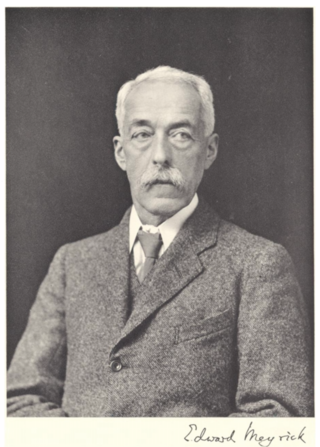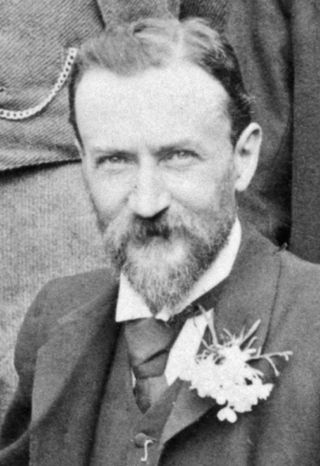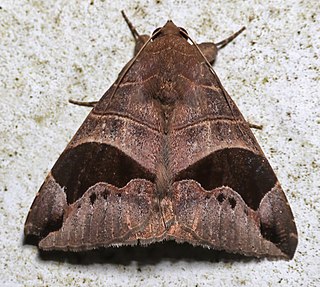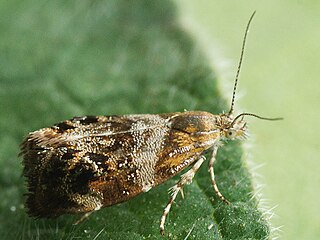
Choristoneura is a genus of moths in the family Tortricidae. Several species are serious pests of conifers, such as spruce and are known as spruce budworms.

The Hepialidae are a family of insects in the lepidopteran order. Moths of this family are often referred to as swift moths or ghost moths.

Edward Meyrick was an English schoolmaster and amateur entomologist. He was an expert on microlepidoptera and some consider him one of the founders of modern microlepidoptera systematics.

Arthur Gardiner Butler F.L.S., F.Z.S. was an English entomologist, arachnologist and ornithologist. He worked at the British Museum on the taxonomy of birds, insects, and spiders.

Per Olof Christopher Aurivillius was a Swedish entomologist.

South Africa, officially the Republic of South Africa, is the southernmost country in Africa. It is bounded to the south by 2,798 kilometres (1,739 mi) of coastline that stretches along the South Atlantic and Indian Oceans; to the north by the neighbouring countries of Namibia, Botswana, and Zimbabwe; and to the east and northeast by Mozambique and Eswatini. It also completely enclaves the country Lesotho. It is the southernmost country on the mainland of the Old World, and the second-most populous country located entirely south of the equator, after Tanzania. South Africa is a biodiversity hotspot, with unique biomes, plant and animal life. With over 62 million people, the country is the world's 23rd-most populous nation and covers an area of 1,221,037 square kilometres. Pretoria is the administrative capital, while Cape Town, as the seat of Parliament, is the legislative capital. Bloemfontein has traditionally been regarded as the judicial capital. The largest city, and site of highest court is Johannesburg.

Tytroca metaxantha is a moth of the family Erebidae first described by George Hampson in 1902. It is found in South Africa and Zimbabwe.

Bastilla joviana is a moth of the family Noctuidae first described by Stoll in 1782. It is found from the Oriental region to the Moluccas and in New Guinea and Australia. It is also present in South Africa.

Micragrotis interstriata is a species of moth of the family Noctuidae first described by George Hampson in 1902. It is found in Africa, including Zimbabwe and South Africa.
Heliothis galatheae is a species of moth of the family Noctuidae first described by Hans Daniel Johan Wallengren in 1856. It is found all over Africa, including South Africa to Ethiopia and the Gambia.

Heliothis leucosticta is a species of moth of the family Noctuidae first described by George Hampson in 1902. It is found in Africa, including Botswana and South Africa.
Heliothis sublimis is a species of moth of the family Noctuidae first described by Emilio Berio in 1962. It is found in Africa, including South Africa.
Heliothis transvaalica is a species of moth of the family Noctuidae first described by William Lucas Distant in 1902. It is found in Transvaal of South Africa and in Namibia.

Heliocheilus multiradiata is a species of moth of the family Noctuidae first described by George Hampson in 1902. It is found in Africa, including South Africa and Zimbabwe.
Varius ochnicola is the only species in the monotypic moth genus Varius of the family Nepticulidae. The genus was erected by Scoble in 1983. The species was first described by Vari in 1955. It is found in South Africa.

Appias epaphia, the diverse white or African albatross, is a butterfly of the family Pieridae. It is found in Africa, south of the Sahara. The habitat consists of forests and heavy woodland.
Titanoptilus stenodactylus is a moth in the family Pterophoridae first described by Thomas Bainbrigge Fletcher in 1911. It is known from South Africa, Tanzania, the Democratic Republic of the Congo and the Comoros.
The Micronoctuini are a tribe of moths in the family Erebidae that includes about 400 described species. Typical species in the tribe have bifine hindwing venation and are smaller than those in other noctuoid moths. Micronoctua karsholti is the smallest of all species in the superfamily Noctuoidea.
Louis Beethoven Prout (1864–1943) was an English entomologist and musicologist.

Tebenna bjerkandrella is a moth of the family Choreutidae first described by Carl Peter Thunberg in 1784. It is found from Europe, Morocco, Madeira and the Canary Islands through central Asia to Japan. It has also been recorded from South Africa.
This page is based on this
Wikipedia article Text is available under the
CC BY-SA 4.0 license; additional terms may apply.
Images, videos and audio are available under their respective licenses.









